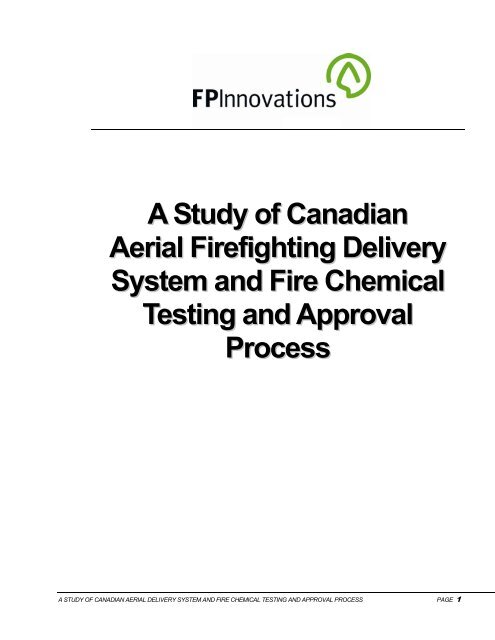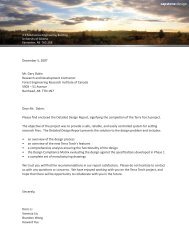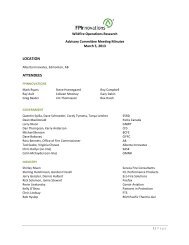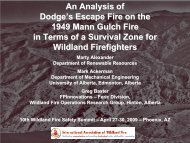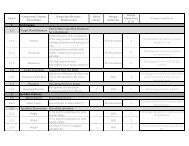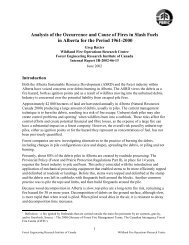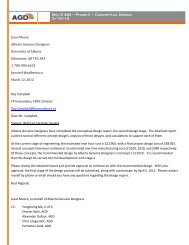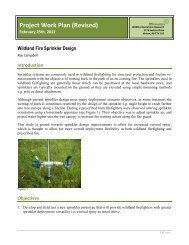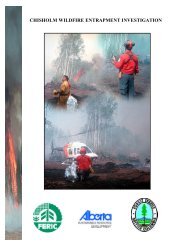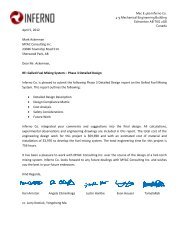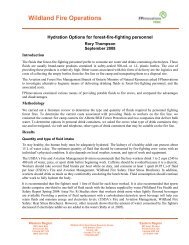A Study of Canadian Aerial Firefighting Delivery System and Fire ...
A Study of Canadian Aerial Firefighting Delivery System and Fire ...
A Study of Canadian Aerial Firefighting Delivery System and Fire ...
You also want an ePaper? Increase the reach of your titles
YUMPU automatically turns print PDFs into web optimized ePapers that Google loves.
A <strong>Study</strong> <strong>of</strong> <strong>Canadian</strong><strong>Aerial</strong> <strong><strong>Fire</strong>fighting</strong> <strong>Delivery</strong><strong>System</strong> <strong>and</strong> <strong>Fire</strong> ChemicalTesting <strong>and</strong> ApprovalProcessA STUDY OF CANADIAN AERIAL DELIVERY SYSTEM AND FIRE CHEMICAL TESTING AND APPROVAL PROCESS PAGE 1
Table <strong>of</strong> ContentsEXECUTIVE SUMMARY.........................................................................................................................................................3BACKGROUND TO CURRENT ISSUES & PROCESS.......................................................................................................5Issues .............................................................................................................................................................................5Current Situation............................................................................................................................................................5PROJECT DESCRIPTION ......................................................................................................................................................8Description .....................................................................................................................................................................8Objectives.......................................................................................................................................................................8Scope .............................................................................................................................................................................9Stakeholders ..................................................................................................................................................................9STAKEHOLDER SURVEY ...................................................................................................................................................11Survey Response ........................................................................................................................................................11Survey Summary.........................................................................................................................................................12AERIAL DELIVERY SYSTEMS ANALYSIS........................................................................................................................15Need.............................................................................................................................................................................15Approach......................................................................................................................................................................15Benefit ..........................................................................................................................................................................16Capacity <strong>and</strong> Cost .......................................................................................................................................................16FIRE CHEMICAL PRODUCTS ANALYSIS.........................................................................................................................17Need.............................................................................................................................................................................17Approach......................................................................................................................................................................17Benefits.........................................................................................................................................................................18Capacity & Cost ...........................................................................................................................................................18FRAMEWORK FOR FUTURE DISCUSSION .....................................................................................................................19Future Direction ...........................................................................................................................................................19Recommendations ......................................................................................................................................................19APPENDICES.........................................................................................................................................................................21Appendix 1 ...................................................................................................................................................................21Appendix 2 ...................................................................................................................................................................25A STUDY OF CANADIAN AERIAL DELIVERY SYSTEM AND FIRE CHEMICAL TESTING AND APPROVAL PROCESS PAGE 2
Section1Executive SummaryA <strong>Study</strong> <strong>of</strong> <strong>Canadian</strong> <strong>Aerial</strong> <strong><strong>Fire</strong>fighting</strong> <strong>Delivery</strong><strong>System</strong> <strong>and</strong> <strong>Fire</strong> Chemical Testing <strong>and</strong> ApprovalProcess<strong>Aerial</strong> firefighting delivery systems <strong>and</strong> fire chemicals are an intricate part <strong>of</strong> suppressing wildl<strong>and</strong>fires. Given the very important <strong>and</strong> expensive nature <strong>of</strong> wildl<strong>and</strong> firefighting, the testing <strong>of</strong> deliverysystems <strong>and</strong> fire chemicals for efficiencies, effectiveness, <strong>and</strong> safe use is believed to be critical tosuccessful operations <strong>and</strong> program delivery. In this study the terminology “aerial firefightingdelivery systems” <strong>and</strong> “fire chemicals” includes airtankers, heli-tankers, belly tanks <strong>and</strong> buckets,<strong>and</strong> fire chemicals includes retardants, foams <strong>and</strong> water-enhancers (gels).This study was completed at the request <strong>of</strong> the FPInnovations fire group advisory committee,which is comprised <strong>of</strong> numerous <strong>Canadian</strong> wildfire management government agencies <strong>and</strong> privatesector companies. The purpose <strong>of</strong> this study is aimed at: a) providing information on current aerialfirefighting delivery systems <strong>and</strong> fire chemicals testing <strong>and</strong> approval process; b) determiningagency <strong>and</strong> company need <strong>and</strong> interest in developing a <strong>Canadian</strong> testing <strong>and</strong> approval strategy;<strong>and</strong> c) providing the fire group advisory committee with a framework for future discussion <strong>and</strong>decision making.This study confirmed the need to test <strong>and</strong> approve aerial firefighting delivery systems <strong>and</strong> firechemicals. However, some companies <strong>and</strong> agencies were reluctant to fully commit to developing acollective <strong>Canadian</strong> strategy. This is perhaps not surprising given the many different government<strong>and</strong> private sector m<strong>and</strong>ates, structures, programs <strong>and</strong> processes involved.Use <strong>of</strong> delivery systems <strong>and</strong> fire chemicals varies from one agency to another <strong>and</strong> the currentapproach taken by most <strong>Canadian</strong> agencies to qualify aerial firefighting delivery systems <strong>and</strong> firechemicals hinges on internal policy, process, <strong>and</strong> access to data <strong>and</strong> st<strong>and</strong>ards generated by theUnited States Department <strong>of</strong> Agriculture (USDA) United States Forest Service (USFS).The <strong>Canadian</strong> Interagency Forest <strong>Fire</strong> Centre (CIFFC) seems to st<strong>and</strong> alone as the only <strong>of</strong>ficiallink between <strong>Canadian</strong> provincial wildl<strong>and</strong> fire agencies. CIFFC members work through theiraviation working group to promote safe, effective <strong>and</strong> efficient use <strong>of</strong> aircraft. CIFFC does notcurrently have an established program that oversees testing <strong>and</strong>, or approval <strong>of</strong> aerial firefightingdelivery systems in Canada; however, CIFFC member agencies have adopted commonspecifications for fire chemicals, such as long term retardants, class a foams <strong>and</strong> water enhancers(gels). <strong>Canadian</strong> specifications <strong>and</strong> qualified product lists are for the most part adopted directlyfrom the USFS program, with some adjustments to both the long-term retardant specificationsA STUDY OF CANADIAN AERIAL DELIVERY SYSTEM AND FIRE CHEMICAL TESTING AND APPROVAL PROCESS PAGE 3
(<strong>Canadian</strong> Addendum) <strong>and</strong> the long-term retardant qualified product list (<strong>Canadian</strong> Long-TermRetardant Qualified Products List, or QPL).The main issues being cited by <strong>Canadian</strong> agencies <strong>and</strong> companies relate to concerns with USFSprogram direction, testing parameters, <strong>and</strong> the absence <strong>of</strong> <strong>Canadian</strong> testing <strong>and</strong> approval process.For example, future USFS delivery system testing may be restricted to systems solely used in theUnited States; USFS fire chemical use may become more restrictive due to environmentalconcerns <strong>and</strong> constraints, which could limit overall product availability <strong>and</strong> competition; testingopportunities are limited <strong>and</strong> testing costs tend to be high; <strong>and</strong> the lack <strong>of</strong> <strong>Canadian</strong> processrestricts competition <strong>and</strong> innovation within Canada. Generally, it is felt that in the absence <strong>of</strong> a<strong>Canadian</strong> testing <strong>and</strong> approval strategy, <strong>Canadian</strong> agencies <strong>and</strong> companies are left overly reliant<strong>and</strong> vulnerable to USFS policy <strong>and</strong> program direction.This study found that developing a <strong>Canadian</strong> testing <strong>and</strong> approval strategy for aerial firefightingdelivery systems <strong>and</strong> fire chemicals will be challenging. Identifying an independent third party tooversee <strong>and</strong> administer a testing <strong>and</strong> approval program, balancing agency need, developingtesting strategies <strong>and</strong> process, working collaboratively with the USFS <strong>and</strong> pursuing inter-agencyagreements represent just a few examples <strong>of</strong> these challenges. There are obvious benefits topursuing universal agreements <strong>and</strong> st<strong>and</strong>ards, both within Canada <strong>and</strong> internationally; however,for a project <strong>of</strong> this magnitude to succeed there needs to be executive level agreement, direction<strong>and</strong> financial support from all interested parties.It should be noted that aerial firefighting delivery systems <strong>and</strong> fire chemicals are administeredunder two separate programs within the USFS. If development <strong>of</strong> a <strong>Canadian</strong> strategy proceeds,most agencies <strong>and</strong> companies feel that <strong>Canadian</strong> process should align with current USFS process<strong>and</strong> st<strong>and</strong>ards where possible. It is also vital that agency program development include privatesector consultation to ensure all issues <strong>and</strong> ideas are addressed.Ultimately, the decision to move forward with a <strong>Canadian</strong> testing <strong>and</strong> approval strategy rests withindividual agency <strong>and</strong> private sector need, ability <strong>and</strong> desire to pursue the initiative. To facilitatefurther advisory committee discussion a list <strong>of</strong> recommendations has been summarized withinsection seven <strong>of</strong> this report “Framework for Future Discussion”.FPInnovations would like to extend their gratitude to all the agencies <strong>and</strong> companies that providedinput into this study. FPInnovations remains committed to the fire group advisory committee <strong>and</strong>this project. Should the advisory committee decide to pursue an aerial delivery systems <strong>and</strong> firechemicals testing <strong>and</strong> approval strategy FPInnovations will continue to provide research support tothe project as needed.A STUDY OF CANADIAN AERIAL DELIVERY SYSTEM AND FIRE CHEMICAL TESTING AND APPROVAL PROCESS PAGE 4
Section2Background to Current Issues &ProcessA <strong>Study</strong> <strong>of</strong> <strong>Canadian</strong> <strong>Aerial</strong> <strong><strong>Fire</strong>fighting</strong> <strong>Delivery</strong><strong>System</strong> <strong>and</strong> <strong>Fire</strong> Chemical Testing <strong>and</strong> ApprovalProcessIssues<strong>Canadian</strong> companies <strong>and</strong> provincial wildl<strong>and</strong> firefighting agencies rely heavily on testing <strong>and</strong>approval process established by the United States Department <strong>of</strong> Agriculture (USDA) ForestService, for decisions related to <strong>Canadian</strong> use <strong>of</strong> aerial firefighting delivery systems <strong>and</strong> firechemicals. Although <strong>Canadian</strong> government agencies <strong>and</strong> companies vary in their involvement,approach <strong>and</strong> process, the general sense is that <strong>Canadian</strong> dependency on USDA Forest Serviceprocess <strong>and</strong> st<strong>and</strong>ards can be restrictive <strong>and</strong>, or may potentially impede future <strong>Canadian</strong> businesspractices.Current SituationThe m<strong>and</strong>ate to fight wildl<strong>and</strong> fire within Canada lies with each province, territory <strong>and</strong>, or federalparks. Most <strong>Canadian</strong> agencies have an aerial firefighting program <strong>of</strong> some type, <strong>and</strong> althoughthere are program similarities, there are also differences in program need, approach <strong>and</strong> process.Companies providing aerial delivery systems, fire chemical products <strong>and</strong> services to <strong>Canadian</strong>government agencies are expected to meet government agency program st<strong>and</strong>ards, <strong>and</strong> in somecases provide for testing results. This being said, there seems to be a common need forgovernment agencies <strong>and</strong> companies to approve <strong>and</strong>, or have aerial delivery systems <strong>and</strong> firechemicals tested <strong>and</strong> approved for use.The <strong>Canadian</strong> Interagency Forest <strong>Fire</strong> Centre (CIFFC) seems to st<strong>and</strong> alone as the only <strong>of</strong>ficiallink between <strong>Canadian</strong> wildl<strong>and</strong> firefighting agencies. CIFFC structure provides for a series <strong>of</strong>working groups which hold regular meetings to discuss common interests, issues <strong>and</strong> programconsistency. The CIFFC Aviation Working Group’s role, as defined under the CIFFC website is asfollows:“The aviation working group was formed in late 1999, with a m<strong>and</strong>ate to promote the safe,effective <strong>and</strong> efficient use <strong>of</strong> aircraft in conjunction with national <strong>and</strong> inter-national fire managementagencies <strong>and</strong> other CIFFC working groups”.A STUDY OF CANADIAN AERIAL DELIVERY SYSTEM AND FIRE CHEMICAL TESTING AND APPROVAL PROCESS PAGE 5
CIFFC is not currently involved in aerial firefighting delivery system testing or approval. However,CIFFC member agencies have adopted common performance requirements <strong>and</strong> specifications forfire chemicals such as long term retardants; class a foams <strong>and</strong> water enhancers (gels). <strong>Canadian</strong>specifications <strong>and</strong> qualified product lists are for the most part taken directly from the USFSprogram, with some adjustments to both the long-term retardant specifications <strong>and</strong> the long-termretardant qualified product list (QPL).CIFFC member agency use <strong>of</strong> long term retardants must meet current USDA Forest ServiceSpecification 5100-304c 1 <strong>and</strong> where indicated differently, the <strong>Canadian</strong> addendum to thatdocument (see Appendix 1 <strong>Canadian</strong> Long-Term Retardant Specification Addendum to USDAForest Service Specification 5100-304c). Use <strong>of</strong> foams must meet USDA Forest ServiceSpecification 5100-307a 2 <strong>and</strong> water-enhancers must meet USDA Forest Service Specification5100-306a 3 . CIFFC also manages a Qualified Product List for all products that have met therequirements outlined in the above specification documents, including a <strong>Canadian</strong> QPL for longtermretardants 4 , foam 5 <strong>and</strong> water-enhancers 6 .The USFS utilizes the San Dimas Technology & Development Center (SDTDC) to test aerialfirefighting delivery systems <strong>and</strong> the Missoula Technology & Development Center (MTDC) to testwildl<strong>and</strong> fire chemicals. Both programs fall under the USFS, with input from various other federal<strong>and</strong> state advisory personnel, <strong>and</strong> both programs work very closely together even though theywork under two different boards.The San Dimas Technology & Development Center conducts three basic aerial delivery systemtests: a) full-scale aerial drop testing <strong>of</strong> new delivery systems over a ground-based sampling grid;b) ground-based static testing to predict the performance <strong>of</strong> new systems that are substantiallysimilar to previously tested systems; <strong>and</strong> c) conformance testing for assets previously tested <strong>and</strong>qualified via static or drop testing. USFS testing <strong>of</strong> aerial delivery systems is overseen by theInteragency Airtanker Board (IAB) who deals with aviation safety, approval procedures <strong>and</strong> testing<strong>of</strong> various aircraft <strong>and</strong> tank systems. The IAB also maintains an approved airtanker listing. Fordetailed information on IAB procedures <strong>and</strong> criteria the following link has been provided:http://www.fs.fed.us/fire/aviation/fixed_wing/airtankers/iab_procedures/iab_procedures.htmlUSFS testing <strong>of</strong> wildl<strong>and</strong> fire chemicals falls under the Wildl<strong>and</strong> <strong>Fire</strong> Chemical <strong>System</strong>s (WFCS)program located at Missoula Technology & Development Center. The WFCS program is overseenby an Interagency <strong>Fire</strong> Chemicals Board, which is somewhat comparable to the IAB. Some <strong>of</strong> thetesting completed within the program includes: a) mammalian toxicity; b) fish toxicity; c) corrosion;d) Biodegradability, as well as a number <strong>of</strong> other tests. The WFCS program also maintainsqualified products listings <strong>of</strong> fire chemical products that have been evaluated <strong>and</strong> meet ForestService requirements. For more information on WFCS procedures <strong>and</strong> criteria the following linkhas been provided:http://www.fs.fed.us/rm/fire/wfcs/index.htm1 http://www.fs.fed.us/rm/fire/wfcs/documents/304c_a3.pdf2 http://www.fs.fed.us/rm/fire/wfcs/documents/307a.pdf3 http://www.fs.fed.us/rm/fire/wfcs/documents/306a.pdf4 http://www.fs.fed.us/rm/fire/documents/ret_can.pdf5 http://www.fs.fed.us/rm/fire/wfcs/documents/qpl_fm1.pdf6 http://www.fs.fed.us/rm/fire/wfcs/documents/qpl_we.pdfA STUDY OF CANADIAN AERIAL DELIVERY SYSTEM AND FIRE CHEMICAL TESTING AND APPROVAL PROCESS PAGE 6
<strong>Canadian</strong> wildl<strong>and</strong> firefighting companies <strong>and</strong> agencies have been able to test aerial deliverysystems under the USFS program providing that IAB approval st<strong>and</strong>ards were followed. Althoughthis relationship continues to exist, there is concern that USFS testing <strong>of</strong> aerial delivery systemsmay become restricted to systems solely used in the United States. If current practice were tochange, it could restrict <strong>Canadian</strong> access to aerial delivery system testing.Past <strong>Canadian</strong> aerial delivery system testing has mainly consisted <strong>of</strong> collaboration betweencompany <strong>and</strong> the host agency. Data collection has been occurring through FPInnovations <strong>and</strong>their collection agreement with the USFS, which essentially provides for data collection <strong>and</strong>analysis <strong>of</strong> test data (see Appendix 2 FPInnovations / USFS Collection Agreement).FPInnovations is scheduled to collect airtanker drop data in British Columbia during the 2011season.One initiative that some <strong>Canadian</strong> agencies see as a priority is the development <strong>of</strong> a <strong>Canadian</strong>aerial delivery system testing grid. There is currently no <strong>of</strong>ficial site(s) or formalized <strong>Canadian</strong>approach to this. However, there has been discussion on needs in terms <strong>of</strong> site type (permanent /non-permanent), site location(s), data collection, resource needs, environmental considerations<strong>and</strong> site selection criteria (See Appendix 2 Grid Selection Criteria Considerations).There are currently no provisions for companies to test wildl<strong>and</strong> fire chemical products in Canada.The USFS does not accept test results from outside labs unless it is part <strong>of</strong> the WFCS testingprocess. Product evaluation at the MDTC lab currently takes 18 to 24 months <strong>and</strong> the companypays for all testing (testing cost ranges from $65,000 to $80,000 depending on the type <strong>of</strong> productbeing tested). As previously mentioned, CIFFC membership does utilize USFS specifications <strong>and</strong>QPL information, with some modification for <strong>Canadian</strong> use.A STUDY OF CANADIAN AERIAL DELIVERY SYSTEM AND FIRE CHEMICAL TESTING AND APPROVAL PROCESS PAGE 7
Section3Project DescriptionA <strong>Study</strong> <strong>of</strong> <strong>Canadian</strong> <strong>Aerial</strong> <strong><strong>Fire</strong>fighting</strong> <strong>Delivery</strong><strong>System</strong> <strong>and</strong> <strong>Fire</strong> Chemical Testing <strong>and</strong> ApprovalProcessDescriptionIn this study the terminology “aerial firefighting delivery systems” <strong>and</strong> “fire chemicals” includesairtankers, heli-tankers, belly tanks <strong>and</strong> buckets, <strong>and</strong> fire chemicals includes retardants, foams <strong>and</strong>water-enhancers (gels).This report addresses the issues <strong>and</strong> opportunities related to testing <strong>and</strong> approval <strong>of</strong> aerialfirefighting delivery systems <strong>and</strong> fire chemical products in Canada. The primary focus <strong>of</strong> thisproject is to provide information related to current testing <strong>and</strong> approval process <strong>and</strong> to gaugestakeholder need <strong>and</strong> interest in developing a <strong>Canadian</strong> aerial delivery systems <strong>and</strong> fire chemicalstesting <strong>and</strong> approval strategy.This project is considered complicated in that it involves numerous <strong>Canadian</strong> wildl<strong>and</strong> firefightingagencies <strong>and</strong> companies, differing jurisdictional programs (opposed to the US model which is runfrom a federal platform) <strong>and</strong> current <strong>Canadian</strong> practice which is very dependent on USFS testingprocess <strong>and</strong> st<strong>and</strong>ards.ObjectivesThis project is aimed at providing information to advisory committee members so informeddiscussions regarding future program direction can take place. The objectives <strong>of</strong> this projectinclude:1. Gathering input from <strong>Canadian</strong> wildl<strong>and</strong> firefighting agencies <strong>and</strong> companies involved intesting <strong>and</strong> approval <strong>of</strong> aerial firefighting delivery systems <strong>and</strong> fire chemicals.2. Providing information on current <strong>Canadian</strong> / USFS testing <strong>and</strong> approval process soadvisory members can clearly underst<strong>and</strong> the issues <strong>and</strong> opportunities surrounding thistopic.3. Providing objective analysis to both <strong>Canadian</strong> aerial delivery systems <strong>and</strong> fire chemicalstesting <strong>and</strong> approval process.A STUDY OF CANADIAN AERIAL DELIVERY SYSTEM AND FIRE CHEMICAL TESTING AND APPROVAL PROCESS PAGE 8
4. Providing a framework for future advisory committee discussion <strong>and</strong> decision making.ScopeThis project <strong>of</strong>ficially began in April, 2009 with an FPInnovations advisory committee decision topursue an airtanker grid strategy. During more recent discussions (October, 2010 advisorycommittee meeting) FPInnovations was asked to exp<strong>and</strong> project focus to include information onfire chemicals testing <strong>and</strong> the <strong>Canadian</strong> QPL process.Consultation with <strong>Canadian</strong> wildl<strong>and</strong> fire agencies, aerial delivery systems <strong>and</strong> fire chemicalcompanies have been on-going. Additional insight has also been solicited from the USFS toensure full underst<strong>and</strong>ing <strong>of</strong> current testing <strong>and</strong> approval process.Testing <strong>and</strong> approval <strong>of</strong> aerial delivery systems vs. fire chemicals are managed as two different<strong>and</strong> distinct programs within the USFS. Although these topics <strong>of</strong>ten overlap <strong>and</strong> are closelyrelated, they will be treated as two separate initiatives within the analysis portion <strong>of</strong> this report.This study does not deal with Transport Canada National Aircraft Certification, which establishes<strong>and</strong> regulates st<strong>and</strong>ards for aeronautical products designed <strong>and</strong> operated in Canada, <strong>and</strong> guidesthe aerospace industry with respect to certification in highly technical fields such as: aircraft design,structures, avionics; electrical <strong>and</strong> mechanical systems; power plants; equipment; <strong>and</strong> engineeringflight tests.Project results are scheduled to be presented at the up-coming advisory committee meeting onMarch 8, 2011.StakeholdersA list <strong>of</strong> stakeholders was developed using FPInnovations membership lists, through generalknowledge <strong>and</strong> internet research. Each stakeholder was consulted through email, phone calls <strong>and</strong>a stakeholder questionnaire.For analysis purposes stakeholders have been broken into four basic groups: GovernmentAgencies; Aviation Service Providers; <strong>Aerial</strong> Product Companies; <strong>and</strong> Other Stakeholders <strong>and</strong>Interested Parties. For reference, a list <strong>of</strong> stakeholders has been provided in Table 1.A STUDY OF CANADIAN AERIAL DELIVERY SYSTEM AND FIRE CHEMICAL TESTING AND APPROVAL PROCESS PAGE 9
Table 1. Stakeholder List.Government AgenciesAlberta Sustainable Resource DevelopmentBritish Columbia Ministry <strong>of</strong> Forests, Mines <strong>and</strong> L<strong>and</strong>sManitoba ConservationNorthwest Territories Department <strong>of</strong> Environment <strong>and</strong> Natural ResourcesNewfoundl<strong>and</strong> <strong>and</strong> Labrador Department <strong>of</strong> Natural ResourcesNew Brunswick Department <strong>of</strong> Natural ResourcesNova Scotia Department <strong>of</strong> Natural ResourcesOntario Ministry <strong>of</strong> Natural ResourcesParks CanadaQuébec – SOPFEU Société de protection des forets contre le feuSaskatchewan Ministry <strong>of</strong> EnvironmentYukon Department <strong>of</strong> Community ServicesCIFFC <strong>Canadian</strong> Interagency <strong>Fire</strong> Fighting CentreAviation Service ProvidersAirborne Energy Solutions LtdAir Spray Ltd.Alpine Helicopters Ltd.Bombardier Inc.Buffalo Airways<strong>Canadian</strong> Air-Crane Ltd.Conair Group Inc.Coulson Aircrane Ltd.Delta Helicopters Ltd.Forest Protection LimitedGreat Slave HelicoptersRemote HelicoptersSlave Lake Helicopters Ltd.Tasman Helicopters LTD.Valhalla Helicopters Inc.VIH Aviation GroupWildcat Helicopters Inc<strong>Aerial</strong> Products CompaniesAbsolute <strong>Fire</strong> Solutions (AFS)ICL Performance Products Canada Ltd.Mercedes Textiles LimitedSEI IndustriesThermo Technologies, LLCWildfire Environmental Inc.Other Stakeholders / Interested PartiesF.T.S. Forest Technology <strong>System</strong>s Ltd.V<strong>and</strong>erwell Contractors (1971) Ltd.United States Department <strong>of</strong> Agriculture / Forest ServiceAlberta Air Attack OfficerA STUDY OF CANADIAN AERIAL DELIVERY SYSTEM AND FIRE CHEMICAL TESTING AND APPROVAL PROCESS PAGE 10
Section4Stakeholder SurveyA <strong>Study</strong> <strong>of</strong> <strong>Canadian</strong> <strong>Aerial</strong> <strong><strong>Fire</strong>fighting</strong> <strong>Delivery</strong><strong>System</strong> <strong>and</strong> <strong>Fire</strong> Chemical Testing <strong>and</strong> ApprovalProcessSurvey ResponseAll agencies <strong>and</strong> companies listed on the stakeholder list were contacted as part <strong>of</strong> anFPInnovations survey aimed at gaining insight <strong>and</strong> information on the current process as well asstakeholder needs <strong>and</strong> interest. In a couple <strong>of</strong> instances multiple survey responses were receivedfrom individual agencies <strong>and</strong> or companies. For the purpose <strong>of</strong> summarizing survey response(Table 2) multiple agency <strong>and</strong> or company responses were counted as one response.Table 2. Survey Response.GOVERNMENT AGENCIES 13 CONTACTED 12 RESPONDED (92%)*Aviation Service Providers 17 Contacted 6 Responded (35%)**<strong>Aerial</strong> Product Companies 6 Contacted 2 Responded (33%)***Other 4 Contacted 3 Responded (75%)Totals 40 Contacted 23 Responded (58%)*Aviation service providers include airtanker companies <strong>and</strong> both large <strong>and</strong> small rotary wingcompanies. Survey responses were received from 3 major airtanker fixed wing companies <strong>and</strong> 3larger rotary wing companies.**<strong>Aerial</strong> product companies include those involved in both delivery products such as buckets, aswell as companies involved in fire chemicals.***Other includes surveys sent to interested advisory members, the USFS, <strong>and</strong> an air attack<strong>of</strong>ficer.A STUDY OF CANADIAN AERIAL DELIVERY SYSTEM AND FIRE CHEMICAL TESTING AND APPROVAL PROCESS PAGE 11
Survey SummaryThe survey questionnaire was primarily focused towards identifying process, interest <strong>and</strong> need. Insome cases, the reader may notice a difference in the number <strong>of</strong> survey respondents <strong>and</strong> thenumber <strong>of</strong> responses to specific survey questions. Differences in numbers are due to respondentdecisions not to answer certain questions. Survey results by question are as follows:Question #2 - Do you currently participate in a process through which aerial firefightingdelivery systems <strong>and</strong> products are approved <strong>and</strong>, or certified?Six respondents noted that they did not participate in a process, while the remainder <strong>of</strong> the respondents indicated thattheir current business practice involved one or more <strong>of</strong> the choices listed (Internal, CIFFC, USFS <strong>and</strong> TransportCanada).Question #3 - How necessary is having a testing process <strong>and</strong>, or access to testing facilitiesfor aerial firefighting delivery systems <strong>and</strong> products to your m<strong>and</strong>ate <strong>and</strong>, or competitiveposition?Only one respondent replied unnecessary; four considered it somewhat necessary; nine felt it necessary <strong>and</strong> sevenrespondents considered this critical (averaged response necessary to critical).Question #4 - How frequently does your agency, or company test aerial firefighting deliverysystems <strong>and</strong>, or products?Five respondents indicated that they never test; five indicated every five years; three every three years; five annually<strong>and</strong> three tested more than once annually.Question #5 - What are the critical challenges faced by your agency, or company in terms<strong>of</strong> testing aerial firefighting delivery systems <strong>and</strong> products?Access to Testing – nine felt this was not difficult; five difficult <strong>and</strong> five very difficult (averaged response difficult).Timelines <strong>of</strong> Test Results – four felt this wasn’t difficult; nine difficult <strong>and</strong> six very difficult (averaged response difficult).Cost <strong>of</strong> Testing – four felt this wasn’t difficult; nine difficult <strong>and</strong> six very difficult. (averaged response difficult).Applicable St<strong>and</strong>ards <strong>and</strong> Test Methods – seven felt this wasn’t difficult; eight difficult <strong>and</strong> four very difficult (averagedresponse difficult).Question #6 - Do you have an interest in partnering <strong>and</strong>, or pursuing a <strong>Canadian</strong> aerialfirefighting delivery systems <strong>and</strong> products testing strategy?Two respondents had no interest; four low interests; eight moderate interests <strong>and</strong> seven committed interest (averagedresponse moderate interest).Question #7 - Please indicate the preferred site type <strong>and</strong> preferred site locations if known.Twelve respondents wanted to see non-permanent sites supported by a mobile trailer <strong>and</strong> seven respondents felt thatpermanent sites were more desirable.Site suggestions included British Columbia, Alberta, Saskatchewan <strong>and</strong> Eastern Canada.A STUDY OF CANADIAN AERIAL DELIVERY SYSTEM AND FIRE CHEMICAL TESTING AND APPROVAL PROCESS PAGE 12
Question #8 - Please identify the types <strong>of</strong> costs that your agency or company incur intesting aerial firefighting delivery systems <strong>and</strong> products.Transportation – six indicated none; six low; five medium <strong>and</strong> three high (averaged response low to medium).Facilities – six indicated none; ten low; three medium <strong>and</strong> one high (averaged response low).Product Sample – five indicated none; eleven low; two medium <strong>and</strong> two high (averaged response low).Manpower – three indicated none; eight low; seven medium <strong>and</strong> two high (averaged response low to medium).Test service <strong>and</strong> Lab – eight indicated none; six low; three medium <strong>and</strong> three high (averaged response low).Questions #9 - Please list any operational considerations or needs that you would requireat a testing site.<strong>Aerial</strong> delivery systems testing – facilities / site must be able to accommodate all types <strong>of</strong> testing, parts / equipmentstorage, alignment with USFS testing requirements <strong>and</strong> st<strong>and</strong>ards, uniformity in test performed <strong>and</strong> the ability toprovide for tamper pro<strong>of</strong> data, accommodate fixed wing <strong>and</strong> rotary wing aircraft, source <strong>of</strong> labour to operate grid, roadaccess, power, vehicles, access to accommodations <strong>and</strong> meals, fuel storage,.Product testing – align with USFS testing requirements, need to meet all provincial legislation, product information(specs <strong>and</strong> manual) <strong>and</strong> guidelines, focus on a process that encourages new innovation <strong>and</strong> products, large grassyarea for foam testing, include tank <strong>and</strong> bucket testing.Question #10 - Is your agency, or company willing to partner <strong>and</strong>, or support a <strong>Canadian</strong>aerial firefighting delivery systems <strong>and</strong> products strategy financially?Seven were not interested; three
Not sure I fully understood the meaning <strong>of</strong> testing. We do practice drops on all A/C preseason to ensure everything isworking ok.Test flights for aircraft are performed weekly.Input to costing would require a more detailed review prior to any funding commitment.For the most part we participate in very little product <strong>and</strong> air delivery system testing. We rely on the work done by otheragencies in both Canada <strong>and</strong> the US.Currently we are not really involved in testing <strong>of</strong> aerial firefighting delivery systems, but would like to be involved in the<strong>Canadian</strong> aerial firefighting delivery systems <strong>and</strong> products testing strategy.A STUDY OF CANADIAN AERIAL DELIVERY SYSTEM AND FIRE CHEMICAL TESTING AND APPROVAL PROCESS PAGE 14
Section5<strong>Aerial</strong> <strong>Delivery</strong> <strong>System</strong>s AnalysisA <strong>Study</strong> <strong>of</strong> <strong>Canadian</strong> <strong>Aerial</strong> <strong><strong>Fire</strong>fighting</strong> <strong>Delivery</strong><strong>System</strong> <strong>and</strong> <strong>Fire</strong> Chemical Testing <strong>and</strong> ApprovalProcessNeedThe majority <strong>of</strong> survey respondents agreed that there is a need for aerial delivery systems testing<strong>and</strong> approval strategy in Canada; however, committed interest in pursuing or supporting a<strong>Canadian</strong> strategy was somewhat subdued. This reluctance by some companies <strong>and</strong> agenciescould be due to differences in organizational structure, need <strong>and</strong> use <strong>of</strong> systems; budgetaryconstraints; <strong>and</strong> reluctance to break from traditional business practice. Agency <strong>and</strong> companyhesitation could also be due to lack <strong>of</strong> knowledge or full underst<strong>and</strong>ing <strong>of</strong> what an aerial deliverytesting <strong>and</strong> approval strategy might involve. It should be noted that company <strong>and</strong> agencyhesitation to commit could change as strategy <strong>and</strong> process becomes clearer.Although there doesn’t appear to be universal commitment, there does appear to be a willingnessfrom agencies <strong>and</strong> companies to move forward with a more formalized approach to aerial deliverysystems testing <strong>and</strong> approval. Given this, there will be a need to identify what the process will looklike <strong>and</strong> involve. Testing strategies will need to be developed <strong>and</strong> agreed to <strong>and</strong> a lead to overseetesting <strong>and</strong> approval process will need to be identified.Of note was significant support to develop a formal <strong>Canadian</strong> aerial testing grid(s). As mentionedearlier in this report <strong>Canadian</strong> <strong>and</strong> USFS aerial delivery system testing has happened in Canada<strong>and</strong> future projects are scheduled. It is believed that formalizing a testing grid(s) could better serve<strong>Canadian</strong> agency <strong>and</strong> company interests, as well as provide an important piece in building a<strong>Canadian</strong> aerial delivery system testing <strong>and</strong> approval process.ApproachA logical approach to proceeding with a testing <strong>and</strong> approval strategy, given needs <strong>and</strong> theunlikelihood <strong>of</strong> having universal agreement from all <strong>Canadian</strong> agencies <strong>and</strong> companies, would beto strike a committee from committed agencies <strong>and</strong> companies. Once a committee has beenformed some <strong>of</strong> the more obvious questions could be addressed, including: Who should lead <strong>and</strong>oversee testing <strong>and</strong> approval process? What should a <strong>Canadian</strong> testing <strong>and</strong> approval strategyencompass? How can process be aligned with existing USFS process? What opportunities existto formalize agreements aimed at providing opportunity <strong>and</strong> reducing cost?A STUDY OF CANADIAN AERIAL DELIVERY SYSTEM AND FIRE CHEMICAL TESTING AND APPROVAL PROCESS PAGE 15
It should be noted that the majority <strong>of</strong> survey respondents felt that an independent third partywould be required to administer <strong>and</strong> oversee an aerial delivery testing <strong>and</strong> approval process. Many<strong>of</strong> these same respondents felt that CIFFC would be a logical choice for this role. Follow-up withthe CIFFC Directors <strong>and</strong> the Aviation Working Group would be required.In terms <strong>of</strong> building a <strong>Canadian</strong> testing <strong>and</strong> approval process, the general feeling was that thisshould not be an exercise to re-invent the wheel, <strong>and</strong> that strategy development should be donecollaboratively with USFS, San Dimas Technology & Development Center, with full considerationto IAB procedures <strong>and</strong> criteria. Based on on-going discussions with the USFS, past testinginitiatives <strong>and</strong> the current data collection agreement between FPInnovations <strong>and</strong> the USFS, thereseems to be a willingness to work collectively towards overall testing improvements <strong>and</strong> mutualbenefit.On the question <strong>of</strong> permanent or non-permanent testing sites, this is a decision best left to theindividual agencies that provide location(s) as each jurisdiction will have different requirements thatwill need to be respected. Discussion between interested parties will yield suggestions for sites.Although it was not part <strong>of</strong> this study, there may be future opportunities to exp<strong>and</strong> agreements <strong>and</strong>working relationships internationally which would further benefit all agencies <strong>and</strong> companies e.g.The USFS has worked cooperatively with Canada <strong>and</strong> Australia in aerial delivery systems testing.BenefitGovernment agencies <strong>and</strong> companies would benefit from a <strong>Canadian</strong> testing <strong>and</strong> approvalstrategy as it will provide for formalized <strong>Canadian</strong> process, testing consistency, increased testingopportunities, testing efficiencies <strong>and</strong> cost savings.Capacity <strong>and</strong> CostGiven individual agency <strong>and</strong> company resource levels, shared responsibility through anagreement or memor<strong>and</strong>um <strong>of</strong> underst<strong>and</strong>ing (MOU) is a logical way to address capacity <strong>and</strong>resource issues. In some cases agencies <strong>and</strong> companies may not be able to contribute financially,but can <strong>of</strong>fer in-kind assistance such as manpower or equipment. A mobile support trailer whichwould hold testing equipment <strong>and</strong> support agency testing in multiple locations would help toeliminate duplication <strong>and</strong> reduce cost.It should be noted that testing aerial delivery systems can be very expensive e.g. FPInnovationshas spent on average $45,000 per airtanker test for their involvement alone.A STUDY OF CANADIAN AERIAL DELIVERY SYSTEM AND FIRE CHEMICAL TESTING AND APPROVAL PROCESS PAGE 16
Section6<strong>Fire</strong> Chemical Products AnalysisA <strong>Study</strong> <strong>of</strong> <strong>Canadian</strong> <strong>Aerial</strong> <strong><strong>Fire</strong>fighting</strong> <strong>Delivery</strong><strong>System</strong> <strong>and</strong> <strong>Fire</strong> Chemical Testing <strong>and</strong> ApprovalProcessNeedThe majority <strong>of</strong> survey respondents agreed that there is a need for aerial delivery systems testing<strong>and</strong> approval strategy in Canada; however, committed interest in pursuing or supporting a<strong>Canadian</strong> strategy was somewhat subdued. This reluctance by some companies <strong>and</strong> agenciescould be due to differences in organizational structure, need <strong>and</strong> use <strong>of</strong> systems; budgetaryconstraints; <strong>and</strong> reluctance to break from traditional business practice. Agency <strong>and</strong> companyhesitation could also be due to lack <strong>of</strong> knowledge or full underst<strong>and</strong>ing <strong>of</strong> what an aerial deliverytesting <strong>and</strong> approval strategy might involve. It should be noted that company <strong>and</strong> agencyhesitation to commit could change as strategy <strong>and</strong> process becomes clearer.CIFFC member agencies essentially already oversee a <strong>Canadian</strong> approval process for firechemical products. Further discussion is needed to determine process improvements <strong>and</strong>direction. There is also a sense among some agencies that fire chemical testing <strong>and</strong> approvalprocess needs to encourage innovative product development <strong>and</strong> provide for open competition inthe market place.ApproachThe current <strong>Canadian</strong> process uses USFS specifications <strong>and</strong> qualified product lists with theaddition <strong>of</strong> a <strong>Canadian</strong> Addendum <strong>and</strong> QPL listing for long-term retardants. CIFFC memberagencies have agreed to use the <strong>Canadian</strong> QPL although some jurisdictions may choose not touse specific products listed on the <strong>Canadian</strong> QPL (i.e. local policy <strong>and</strong>, or environmentalconstraints).Some agencies feel that exp<strong>and</strong>ing the current <strong>Canadian</strong> process to include pr<strong>of</strong>essional sign-<strong>of</strong>f<strong>and</strong>, or third party laboratory testing could lessen overall testing cost <strong>and</strong> provide increasedopportunity for new <strong>and</strong> innovative products. In some cases companies may already be engagedin preliminary testing prior to entering the USFS process. Recognition <strong>of</strong> these testing resultsunder the proper testing protocol <strong>and</strong> sign-<strong>of</strong>f could benefit companies <strong>and</strong> agencies alike. TheUSFS does not currently accept laboratory testing outside <strong>of</strong> their established process, soduplicate testing would be required for those companies wishing to access the US market. TheA STUDY OF CANADIAN AERIAL DELIVERY SYSTEM AND FIRE CHEMICAL TESTING AND APPROVAL PROCESS PAGE 17
USFS was not approached during this study on the question <strong>of</strong> accepting a <strong>Canadian</strong> process, norhave the possible opportunities or parameters that might apply been determined. It is likelyhowever that a <strong>Canadian</strong> process would need to equal or exceeded USFS st<strong>and</strong>ards if it were tobe accepted by the USFS<strong>Canadian</strong> testing process would likely be financed through a user- pay scheme much like theUSFS process. Adjustment to the <strong>Canadian</strong> QPL process would require CIFFC Director <strong>and</strong>Aviation Working Group agreement <strong>and</strong> approval.FPInnovations has laboratory testing facilities that could possibly provide third party testing. Earlyindications are that some <strong>of</strong> this testing could be done quicker <strong>and</strong> at less cost. FPInnovations ispursuing additional information on testing <strong>and</strong> will make this information available to interested firecommittee members.BenefitsChanges to the <strong>Canadian</strong> QPL process to accept independent testing results under the properprotocol <strong>and</strong> sign-<strong>of</strong>f could lessen overall testing cost <strong>and</strong> provide increased opportunity for new<strong>and</strong> innovative product use.Capacity & CostGovernment agencies <strong>and</strong> companies would benefit from a <strong>Canadian</strong> testing <strong>and</strong> approvalstrategy as it will provide for formalized <strong>Canadian</strong> process, increased testing opportunities, testingefficiencies <strong>and</strong> potentially cost savings. Given individual agency <strong>and</strong> company resource levels,shared responsibility through an agreement or memor<strong>and</strong>um <strong>of</strong> underst<strong>and</strong>ing (MOU) is a logicalway to address capacity <strong>and</strong> resource issues. Given the existence <strong>of</strong> a <strong>Canadian</strong> QPL processprogram development should be build on existing process <strong>and</strong> incorporate improvements thatfavour an open <strong>and</strong> competitive process.Current USFS testing can be very expensive e.g. current testing runs between $65,000 <strong>and</strong>$80,000 depending on the type <strong>of</strong> product being tested.A STUDY OF CANADIAN AERIAL DELIVERY SYSTEM AND FIRE CHEMICAL TESTING AND APPROVAL PROCESS PAGE 18
Section7Framework for Future DiscussionA <strong>Study</strong> <strong>of</strong> <strong>Canadian</strong> <strong>Aerial</strong> <strong><strong>Fire</strong>fighting</strong> <strong>Delivery</strong><strong>System</strong> <strong>and</strong> <strong>Fire</strong> Chemical Testing <strong>and</strong> ApprovalProcessFuture Direction<strong>Canadian</strong> aerial firefighting delivery systems <strong>and</strong> fire chemicals testing <strong>and</strong> approval strategydevelopment is ultimately driven by individual business need. The benefit to having national <strong>and</strong>international consistency is fairly obvious; however pursuing a <strong>Canadian</strong> model is complicated bydiffering government <strong>and</strong> private sector programs, processes <strong>and</strong> interests. Development <strong>of</strong> a<strong>Canadian</strong> strategy <strong>of</strong> this magnitude involves inter-agency agreements, testing strategies,development <strong>of</strong> st<strong>and</strong>ards <strong>and</strong> approval processes <strong>and</strong> equipment <strong>and</strong> resource dedication.Advancing this strategy will require initiative, leadership <strong>and</strong> support. The decision to move forwardwith a national approach will rest entirely on agency <strong>and</strong> company willingness to participate in, <strong>and</strong>support the process financially. This decision will obviously require support at an executivemanagement level to be successful.RecommendationsBased on the information gathered through this study, it is obvious that there is need <strong>and</strong> interestin pursuing an aerial delivery systems <strong>and</strong> fire chemical testing <strong>and</strong> approval strategy <strong>and</strong>, orimprovements to the current process. The following recommendations are <strong>of</strong>fered forconsideration to further process development:1. It is recommended that interested parties form a committee to determine direction <strong>and</strong> advancedevelopment <strong>of</strong> a <strong>Canadian</strong> aerial firefighting delivery systems <strong>and</strong> fire chemicals testing <strong>and</strong>approval strategy.2. The stakeholder survey identified the need for an independent third party to oversee <strong>and</strong>administer a testing <strong>and</strong> approval process. As mentioned within this report, there are twoseparate <strong>and</strong> distinct testing <strong>and</strong> approval processes which need to be addressed:a. <strong>Aerial</strong> <strong>Delivery</strong> <strong>System</strong>s - Currently, Canada does not have an aerial delivery systemtesting <strong>and</strong> approval process. Many <strong>of</strong> the agencies <strong>and</strong> companies noted CIFFC as alogical entity to administer <strong>and</strong> oversee this program. It is recommended that thoseA STUDY OF CANADIAN AERIAL DELIVERY SYSTEM AND FIRE CHEMICAL TESTING AND APPROVAL PROCESS PAGE 19
agencies interested in pursuing this initiative (as per recommendation #1), bring thistopic forward through the CIFFC Aviation Working Group.b. <strong>Fire</strong> Chemicals - CIFFC already oversees a fire chemicals approval process. It isrecommended that suggestions for process improvement be vetted through the CIFFCAviation Group <strong>and</strong> incorporated into the current process.3. Further discussion is required on the topic <strong>of</strong> fire chemical testing <strong>and</strong> approval process. Thisdiscussion should be vetted as per recommendation 2 (b). Specifically,a. It is recommended that <strong>Canadian</strong> testing process be developed in such a way toencourage both opportunity <strong>and</strong> innovation.b. It is also recommended that <strong>Canadian</strong> testing requirements be thoroughly studied. Thisis a complicated topic that requires more research <strong>and</strong> expert opinion. Ensuring USFSalignment <strong>and</strong> appropriate <strong>Canadian</strong> testing methods <strong>and</strong> protocol is critical to<strong>Canadian</strong> process development.4. It is recommended that an aerial grid testing strategy be pursued.a. A grid strategy should include identification <strong>of</strong> potential sites, testing process <strong>and</strong>st<strong>and</strong>ards, <strong>and</strong> required support (Note: grid selection criteria have been provided inappendix 2; equipment support requirements can be determined via the FPInnovations /USFS Data Collection Agreement).b. It is also recommended that an equipment support trailer be assembled to supportoperational field testing at the grid site(s). Content can be determined by referencing theFPInnovations / USFS Data Collection Agreement <strong>and</strong>, or USFS model.FPInnovations would like to extend their gratitude to all the agencies <strong>and</strong> companies that providedinput into this study. FPInnovations remains committed to the fire group advisory committee <strong>and</strong>this project. Should the advisory committee decide to pursue an aerial delivery systems <strong>and</strong> firechemicals testing <strong>and</strong> approval strategy FPInnovations will continue to provide research support tothe project as needed.A STUDY OF CANADIAN AERIAL DELIVERY SYSTEM AND FIRE CHEMICAL TESTING AND APPROVAL PROCESS PAGE 20
Section8 AppendicesA <strong>Study</strong> <strong>of</strong> <strong>Canadian</strong> <strong>Aerial</strong> <strong><strong>Fire</strong>fighting</strong> <strong>Delivery</strong><strong>System</strong> <strong>and</strong> <strong>Fire</strong> Chemical Testing <strong>and</strong> ApprovalProcessAppendix 1<strong>Canadian</strong> Long-Term Retardant Specification Addendum to USDA Forest ServiceSpecification 5100-304c<strong>Canadian</strong> Interagency Forest <strong>Fire</strong> Centre (CIFFC) member agencies have adopted a common performancerequirement for long term retardant. The basic tenet is the current United States Department <strong>of</strong> Agriculture(USDA) – Forest Service Specification 5100 304c. To be considered for operational use in Canada, all long-termfire retardants must satisfy the performance requirements contained in 5100 304c <strong>and</strong> where indicated differentlyin this <strong>Canadian</strong> Addendum.These requirements are designed to ensure that chemical fire retardant products used by CIFFC memberagencies are effective, efficient <strong>and</strong> safe. Products that satisfy the requirements <strong>of</strong> the USDA 5100 304cspecification <strong>and</strong> are fully qualified for use by the U.S. Forest Service are considered to meet the CIFFC memberagencies’ requirements at the US mix ratio. However, the <strong>Canadian</strong> retardant effectiveness requirement is;A reduction index equal to 90% <strong>of</strong> the reduction index <strong>of</strong> the st<strong>and</strong>ard chemical, 10.6 percentdiammonium phosphate (DAP) shall be acceptable.The submitter shall specify the mix ratio for which the product is designed <strong>and</strong> qualification is being sought, the<strong>Canadian</strong> mix ratio.This document presents a reference to the CIFFC member agencies’ differing Submission <strong>and</strong> Evaluation,Requirements, Test Procedures <strong>and</strong> Qualification sections from those stated within the 5100 304c specification.All qualifying testing shall be coordinated by the USDA Forest Service Wildl<strong>and</strong> <strong>Fire</strong> Chemical <strong>System</strong>s (WFCS).A vendor submitting product intended for both the United States <strong>and</strong> <strong>Canadian</strong> markets shall notify CIFFC <strong>of</strong>their intention however will make a request for evaluation to the Branch Chief, <strong>Fire</strong> Equipment <strong>and</strong> ChemicalsUSDA Forest Service <strong>and</strong> will enter into a collection agreement with the Forest Service Missoula Technology<strong>and</strong> Development Centre (MTDC), Wildl<strong>and</strong> <strong>Fire</strong> Chemical <strong>System</strong>s Laboratory (WFCS). This process is outlinedin the Manufacturer Submission Procedures for Qualification Testing <strong>of</strong> Long Term Retardant Productsdocument.A vendor submitting product solely intended for the <strong>Canadian</strong> market shall follow the process outlined in ForestService Specification 5100-304c subject to the following amendments in Submission <strong>and</strong> EvaluationRequirements, Test Procedures <strong>and</strong> Qualification sections outlined within this document <strong>and</strong> will enter into acollection agreement with the <strong>Canadian</strong> Interagency Forest <strong>Fire</strong> Centre.A STUDY OF CANADIAN AERIAL DELIVERY SYSTEM AND FIRE CHEMICAL TESTING AND APPROVAL PROCESS PAGE 21
The amended requirements <strong>and</strong> test procedures sections as summarized within this document shall apply to allproducts intended for use in Canada regardless <strong>of</strong> whether the product is submitted for evaluation for the entireNorth American market or the <strong>Canadian</strong> market only.Submission <strong>and</strong> Evaluation.The following numbered Submission <strong>and</strong> Evaluation sections differ from those within the 5100-304cspecification.2.3 Manufacturer Submission Process. The submitter (manufacturer, distributor, or supplier) shall make arequest for evaluation to the Director, CIFFC.2.3.3 Collection Agreement <strong>and</strong> Test Fee. A collection agreement between CIFFC <strong>and</strong> the submitter will beprepared. This document describes the roles <strong>and</strong> responsibilities <strong>of</strong> CIFFC <strong>and</strong> the submitter. Specificinformation in the agreement includes a list <strong>of</strong> authorized contacts for CIFFC <strong>and</strong> the submitter as well as anestimate <strong>of</strong> the cost <strong>and</strong> time required for the evaluation.2.3.4 Product Information. All product information described below shall be provided to CIFFC for review <strong>and</strong>will in turn be forwarded to the Forest Service for review by a designated agency representative, as summarizedin 2.4 <strong>and</strong> described in “Manufacturer Submission Procedures for Qualification Testing <strong>of</strong> Long-Term RetardantProducts) prior to acceptance <strong>of</strong> samples for testing.2.3.4.1 Proprietary Information. The formulation disclosure <strong>and</strong> other product information provided to theCIFFC <strong>and</strong> copied to the Forest Service as part <strong>of</strong> the submission process will be maintained for use during theevaluation process. The Forest Service will only retain records through the life <strong>of</strong> the work order <strong>and</strong> uponcompletion <strong>of</strong> all testing. The original set will be sent to CIFFC. All proprietary or sensitive information provided tothe Forest Service is kept in a locked file accessible only to the Program Leader <strong>and</strong> Project Leader <strong>of</strong> WFCS.At CIFFC all proprietary or sensitive information is kept in a locked file accessible only to the Director <strong>and</strong> theAviation Manager. Occasionally information will be provided in response to inquiries from the Directors <strong>of</strong><strong>Canadian</strong> user agencies or their staffs.2.3.4.2 Access to Information Under the Freedom <strong>of</strong> Information Act.Delete this section as it does not apply2.3.4.5 Health <strong>and</strong> Safety Information. The submitter shall provide the following safety information to CIFFC forreview, prior to shipping the product:a. M<strong>and</strong>atory: Material safety Data Sheet (MSDS) for the proposed product.b. M<strong>and</strong>atory: MSDS for each ingredient <strong>of</strong> the proposed product.c. Optional: Summary <strong>of</strong> any toxicity or related safety results conducted by or for the manufacturer prior tosubmission to CIFFC.2.4 Review Prior to Product Submittal (STP-1). The Aviation Manager, CIFFC <strong>and</strong> the Project Leader, WFCSshall review the documentation package for completeness <strong>and</strong> consistency. Any questions that may arise shallbe resolved at that time.2.4.1 Chemicals <strong>of</strong> Concern. A review <strong>of</strong> environmental regulations as they apply to the formulation <strong>and</strong> theingredients <strong>of</strong> the formulation shall be completed at the same time. Specifically, the status <strong>of</strong> each chemical withregard to the regulatory lists shown below shall be determined.a. 40 Code <strong>of</strong> Federal Regulations (CFR) 335 Appendix A. – Comprehensive Environmental Response,Compensation <strong>and</strong> liability Act (CERCLA), List <strong>of</strong> Extremely Hazardous Substances <strong>and</strong> Reportable Quantities.b. National Toxicology Program’s Annual Report on Carcinogensc. International Agency for Research on Cancer (IARC) Monographs for Potential Carcinogens.d. 40 CFR 302.4 - CERCLA, List <strong>of</strong> hazardous Substances <strong>and</strong> Reportable Quantities.e. 40 CFR 261.33 - Resources Conservation <strong>and</strong> Recovery Act (RCRA), Acutely Hazardous <strong>and</strong> Toxic Wastes.f. 40 CFR 372.- Superfund Amendment <strong>and</strong> Reauthorization ACT (SARA) Title III, sec 313, Emergency Planning<strong>and</strong> Community Right to Know (EPCRA), Toxic Release Inventory (TRI)g. Toxic Substances List, <strong>Canadian</strong> Environmental Protection Act 1999 CIFFC is responsible to review)A STUDY OF CANADIAN AERIAL DELIVERY SYSTEM AND FIRE CHEMICAL TESTING AND APPROVAL PROCESS PAGE 22
2.4.2 Chemical Pr<strong>of</strong>ile <strong>and</strong>/or Risk Assessment. If any <strong>of</strong> the ingredients trigger concern, a basic chemicalpr<strong>of</strong>ile <strong>and</strong>/or risk assessment may be required before further action is taken on the formulation evaluation.CIFFC shall make a written notification to the submitter <strong>of</strong> these concerns <strong>and</strong> include the acceptable remedies<strong>and</strong> associated costs. The submitter has the choice to continue or not at this point <strong>and</strong> shall be asked to notifyCIFFC in writing <strong>of</strong> that decision. If required, this risk assessment shall be performed by the Forest Service onbehalf <strong>of</strong> CIFFC or an approved third-party selected by the Forest Service, using accepted methodology. Allcosts associated with the additional work shall be the responsibility <strong>of</strong> the submitter.2.5 Submission <strong>of</strong> Samples for Laboratory Evaluation. When requested, <strong>and</strong> at no cost to CIFFC or theForest Service, the submitter shall provide the required amount <strong>of</strong> concentrate for use in the laboratoryevaluation tests.Requirements.The Following requirements differ from those found in USDA Forest Service Specification 5100-304c.3.1 Evaluation Samples <strong>and</strong> Mix Ratio. The evaluation shall be conducted on the concentrate <strong>and</strong> on themixed product prepared using the manufacturer’s recommended <strong>Canadian</strong> mix ratio or other mix ratio asdescribed below. The mix ratio shall be confirmed by combustion retarding effectiveness testing <strong>and</strong> if adjusted,agreed to by the submitter. The mixed product prepared using the <strong>Canadian</strong> mix ratio agreed to by the submitter<strong>and</strong> WFCS shall be used throughout this evaluation.3.5 Combustion-Retarding Effectiveness. All mixed retardants shall meet the criteria in 3.5.1 <strong>and</strong> 3.5.3.3.5.2 Required Retarding Salt Concentration. This section is not applicable to the <strong>Canadian</strong> mix ratio as thevolume <strong>of</strong> test results does not exist to determine required Retarding Salt Concentration. Therefore, 3.5.3Combustion Retarding Effectiveness Test shall apply for all mixed retardant.3.5.3 Combustion Retarding Effectiveness Test. All products shall undergo a fire effectiveness test inaccordance with 4.5. A reduction index equal to 90% <strong>of</strong> the reduction index <strong>of</strong> the st<strong>and</strong>ard chemical, 10.6 –percent DAP, shall be acceptable.3.6.3.1 Retarding Salt Content. When tested in accordance with 4.6, the retarding salt content shall meet therequirements <strong>of</strong> 3.5.3. The results will be made available to users as performance information.3.4, 3.6, 3.7, 3.8, 3.9, 3.10, <strong>and</strong> 3.11 All tests designated for mixed retardant shall be conducted at the <strong>Canadian</strong>Mix ratio.3.10.1 Colour <strong>of</strong> iron-Oxide Coloured Retardant. The iron oxide coloured mixed retardant shall contain aminimum <strong>of</strong> 3.17 g/l to impart red colour to the mixed retardant. Mixed retardant with less iron oxide colourantshall be assessed for Field Visibility (3.10.3)3.10.3 Field Visibility. In accordance with 4.10.2, the visibility <strong>of</strong> each mixed retardant shall be determined by anexperienced observer team designated by CIFFC member agencies <strong>and</strong> shall meet the requirements in 3.10.3.1,3.10.3.2 <strong>and</strong> 3.10.3.3Test Procedures.The following explanation <strong>of</strong> test procedures differs from the text found within USDA Forest Service Specification5100-304c.4.5 Combustion retarding Effectiveness Test (STP-2). As required by 3.5.3, the combustion retardingeffectiveness <strong>of</strong> the mixed retardant shall be determined. Fuel beds <strong>of</strong> aspen excelsior or Ponderosa pineneedles shall be prepared <strong>and</strong> treated with mixed retardant or 10.6 percent diammonium phosphate (control)<strong>and</strong> then dried at a st<strong>and</strong>ard temperature <strong>and</strong> humidity to remove the water contained in the retardant or control.The mixed retardant-treated fuel beds shall be tested <strong>and</strong> the effect <strong>of</strong> the mixed retardant on the rate <strong>of</strong> flamespread <strong>and</strong> rate <strong>of</strong> fuel loss determined. The reduction index shall be calculated by comparing the rate <strong>of</strong> flamespread <strong>and</strong> rate <strong>of</strong> weight loss <strong>of</strong> the retardant -treated <strong>and</strong> control -treated beds made from the same fuels asthe treated beds.A STUDY OF CANADIAN AERIAL DELIVERY SYSTEM AND FIRE CHEMICAL TESTING AND APPROVAL PROCESS PAGE 23
4.10.2 Field Evaluation <strong>of</strong> Product Visibility (STP-10.3) As required by 3.10.3, the uncoloured, iron oxidecoloured <strong>and</strong> fugitive coloured mixed retardant shall be tested for visibility on a variety <strong>of</strong> fuel types <strong>and</strong>conditions (slope, aspect, daylight conditions <strong>and</strong> weather).An experienced observer team, in the air at 2500 feet (762m) AGL, directly overhead, <strong>and</strong> on the ground, shallevaluate the visibility <strong>of</strong> each product applied by air dropping or ground tanker application depending onmanufacturer’s designated use.Qualification.The following qualification statements differ from the text found within USDA Forest Service Specification 5100-304c.5.1.1 Additional Testing at the Discretion <strong>of</strong> CIFFC Member Agencies. Additional tests not specified in thisdocument may be required at the discretion <strong>of</strong> the CIFFC member agencies as advised by the USDA ForestService when information provided in the product information or otherwise known to the CIFFC memberagencies or USDA Forest Service suggests a need. The submitter shall be informed, before any additionaltesting is performed, <strong>of</strong> the specific tests to be performed, the reason for the tests <strong>and</strong> the cost <strong>of</strong> the tests. Allcosts <strong>of</strong> the additional testing shall be borne by the submitter.5.1.2 Waiver <strong>of</strong> Testing at the Discretion <strong>of</strong> the CIFFC Member Agencies. At the discretion <strong>of</strong> the CIFFCmember agencies after consultation with the Forest Service, the requirement for the performance <strong>of</strong> specifictests may be waived. When a test is waived, a written notice <strong>of</strong> the decision will be prepared by the CIFFCMember Agencies <strong>and</strong> provided to the submitter.5.2 Notice <strong>of</strong> Qualification. When the information submitted in accordance with 2.3.4 has been approved <strong>and</strong>the product is tested <strong>and</strong> found to meet all requirements <strong>of</strong> section 3, the products will be added to the CIFFCQualified Products List (QPL) <strong>and</strong> an informal notification made to the supplier. A formal Notice <strong>of</strong> ProductQualification shall be issued in writing by the Director, CIFFC.5.3 Notice <strong>of</strong> Failure to Qualify. The submitter shall be notified in writing within 45 days following completion <strong>of</strong>testing if qualification cannot be granted. Written notification shall include all test results <strong>and</strong> identifyunacceptable performance. Notice shall be made by the Director, CIFFC.5.4 Qualification <strong>of</strong> Changed or Modified Product. The Director, CIFFC shall be notified <strong>of</strong> plannedformulation changes <strong>of</strong> products destined for the <strong>Canadian</strong> market. Any change to the formulation, including butnot limited to changes in the type, quantity, quality, processing, supplier, manufacturer, or manufacturing site<strong>of</strong> individual ingredients shall be considered a formulation change. Qualification testing may be required for anyformulation change deemed significant by the CIFFC member agencies in consultation with the USDA ForestService.5.5 Acceptance Inspection <strong>and</strong> Quality Assurance Tests. In consultation with the WFCS, CIFFC memberagencies shall establish requirements <strong>and</strong> procedures for lot acceptance <strong>and</strong> quality assurance <strong>of</strong> fieldshipments <strong>of</strong> product.5.6 Other Tests. CIFFC member agencies reserve the right to perform any other tests they deem necessary atagency expense.A STUDY OF CANADIAN AERIAL DELIVERY SYSTEM AND FIRE CHEMICAL TESTING AND APPROVAL PROCESS PAGE 24
Appendix 2GRID SELECTION CRITERIAAn ideal permanent testing location would be adaptable to any future drop testing, <strong>and</strong> take inconsideration the following criteria:1. It should have road access.2. It should be free <strong>of</strong> other operations.3. It should be within a fifteen minute flight from an established airtanker base facility, <strong>and</strong> be inclose proximity to aircraft servicing <strong>and</strong> retardant filling.4. It should be nearby reservoirs capable <strong>of</strong> supporting water-scooping aircraft.5. It should include a large flat area large enough to set up the sampling grid.6. It should be relatively free <strong>of</strong> community conflicts or over flight issues.7. It should be climactically acceptable <strong>and</strong> have dependable periods <strong>of</strong> warm, dry weather withrelatively stable winds. Windy areas, or coastal <strong>and</strong> valley locations can have morning fog,which make them undesirable.8. It should have access to good support for helicopters.9. There should be access to a local workforce <strong>of</strong> at least twenty to fifty people that can be calledon for grid test labour.10. A power supply is desirable, but not m<strong>and</strong>atory.11. L<strong>and</strong> management needs in terms <strong>of</strong> legislative <strong>and</strong> environmental requirements should bemeet.12. Other considerations for operational testing (see FPInnovations / USFS Collection Agreement )A STUDY OF CANADIAN AERIAL DELIVERY SYSTEM AND FIRE CHEMICAL TESTING AND APPROVAL PROCESS PAGE 25


